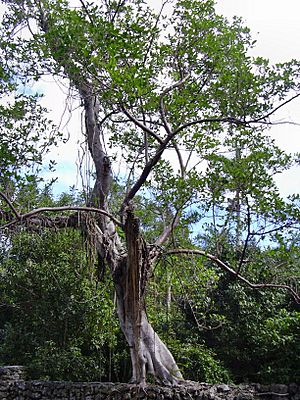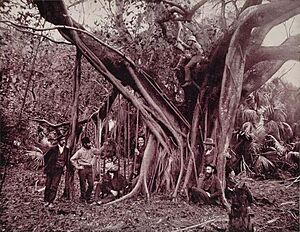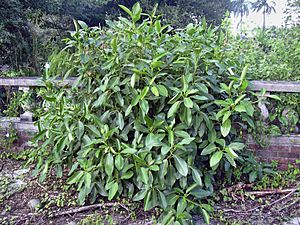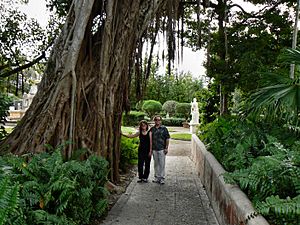Florida strangler fig facts for kids
Quick facts for kids Florida strangler fig |
|
|---|---|
 |
|
| Florida strangler fig in Deering Park, Florida | |
| Scientific classification | |
| Genus: |
Ficus
|
| Species: |
aurea
|
| Synonyms | |
|
Synonymy
Ficus cabusana Standl. & Steyerm.
Ficus ciliolosa Link 1822, rejected name Ficus cookii Standl. Ficus dimidiata Griseb. Ficus isophlebia Standl. Ficus jimenezii Standl. Ficus laterisyce W.C. Burger Ficus lundellii Standl. Ficus mayana Lundell Ficus rigidula Lundell Ficus sapotifolia Kunth & C.D.Bouché Ficus tecolutensis (Liebm.) Miq. Ficus tuerckheimii Standl. Ficus venusta Kunth & C.D. Bouché Ficus warczewiczii (Miq.) Miq. Urostigma tecolutense Liebm. Urostigma venustum (Kunth & C.D.Bouché) Miq. Urostigma warczewiczii Miq. |
|
The Florida strangler fig, also known as the golden fig or higuerón, is a special type of tree. Its scientific name is Ficus aurea. It belongs to the Moraceae family, which also includes mulberries. This tree grows naturally in places like Florida in the U.S., parts of the Caribbean, southern Mexico, and Central America down to Panama. The name aurea means 'golden' in Latin, and it was given by botanist Thomas Nuttall in 1846.
This fig is called a "strangler fig" because of how it grows. It often starts its life high up on another tree, like a plant living on a host. Its roots then grow down to the ground. Once the roots reach the soil, the fig tree grows bigger and stronger. It wraps around its host tree, eventually "strangling" it and taking its place. The Florida strangler fig can grow very tall, up to 30 meters (about 98 feet) high!
Like all fig trees, the Florida strangler fig has a unique partnership with tiny fig wasps. The fig tree needs these wasps to pollinate its flowers, and the wasps need the fig flowers to lay their eggs and reproduce. This tree provides a home and food for many animals, including birds, mammals, reptiles, and insects. People also use F. aurea in traditional medicine, for making living fences, as an ornamental plant, and even as a bonsai.
Contents
What Does the Florida Strangler Fig Look Like?
The Florida strangler fig can grow up to 30 meters (about 98 feet) tall. Each tree has both male and female flowers, which is called being monoecious.
The leaves of this tree can look different from one plant to another. Some leaves are smaller, less than 10 centimeters (4 inches) long. Others are larger. The shape of the leaves also varies. Some are oval or elliptic, while others are heart-shaped.
The figs themselves grow in pairs and are green when they are young. As they ripen, they turn yellow. Their size can also vary, usually between 0.6 and 1.2 centimeters (0.2 to 0.5 inches) across. Most figs grow directly on the branch without a stalk, but in some areas, they grow on short stalks called peduncles.
How the Florida Strangler Fig Reproduces and Grows
The Amazing Partnership with Fig Wasps
Figs and fig wasps have a special relationship called mutualism. This means they both help each other to survive. Fig trees can only be pollinated by fig wasps, and fig wasps can only reproduce inside fig flowers. Usually, each type of fig tree has its own specific type of wasp. For the Florida strangler fig, its pollinator is a wasp called Pegoscapus mexicanus.
Fig flowers are hidden inside a special structure called a syconium. This is what we usually call the "fig fruit." The only opening to the outside is a tiny hole called an ostiole. In trees like F. aurea, both male and female flowers are inside this syconium.
Here's how the process works:
- First, the female flowers inside the fig ripen. They release a special scent to attract female wasps.
- Female wasps squeeze through the tiny ostiole into the fig.
- Inside, they pollinate the flowers and lay their eggs in some of them. After laying their eggs, the female wasps die inside the fig.
- The eggs hatch, and the baby wasps (larvae) grow inside the flowers.
- After about four to seven weeks, adult wasps emerge. The male wasps come out first. They mate with the females and then chew holes through the fig's wall to create exits.
- Around the same time, the male flowers inside the fig ripen. The newly emerged female wasps collect pollen from these male flowers.
- They then leave the fig through the holes made by the males and fly off to find a new fig to lay their eggs in.
- Over the next few days, the figs ripen fully. Birds and mammals eat these ripe figs, helping to spread the seeds.
Flowering and Fruiting Schedule
Fig trees don't all flower and fruit at the same time. Instead, they do it at different times throughout the year. This is very important for the fig wasps. Female wasps need to find a new fig to lay eggs in within a few days of emerging. If all the trees fruited at once, there might not be enough figs available for the wasps.
This staggered fruiting also makes figs a vital food source for animals that eat mostly fruit, especially when other fruits are scarce.
Even within a single Florida strangler fig tree, the flowering and fruiting can happen at different times. This might help the tree keep enough wasps around, especially if there aren't many fig trees nearby or if the climate changes a lot during the year.
Here's a simple look at the fig's flowering stages:
| Flowering Stages in Ficus aurea | ||
| Stage | What Happens | How Long It Lasts |
|---|---|---|
| A (Pre-Female) | Flowers are not yet mature | 2 days to over 9 months |
| B (Female) | Female flowers are ready for pollination; female wasps lay eggs | 1 day to 3 weeks |
| C (Interfloral) | Fig seeds and wasp larvae grow | 4 to 7 weeks |
| D (Male) | Male flowers mature; wasps emerge, mate, and female wasps leave | 1 to 2 days |
| E (Post-Floral) | Fruits ripen | 1 to 5 days |
For most fig species, stage A quickly leads to stage B. But for the Florida strangler fig, the young flowers can stay dormant (inactive) for more than nine months before they start to ripen.
How the Tree Grows
The Florida strangler fig is a fast-growing tree. It starts as an epiphyte, meaning its seed sprouts in the branches of another tree. Then, its roots grow down towards the ground.
It's called a "strangler fig" because its roots wrap around the host tree. These roots can even fuse together, forming a net around the host. This often kills the host tree because it cuts off its ability to grow. However, palm trees are not affected in the same way because their trunks are different. Still, the fig can harm palms by competing for sunlight, water, and nutrients. After Hurricane Andrew in 1992, many F. aurea trees grew back quickly from their roots or from remaining parts of the tree.
Where the Florida Strangler Fig Lives
The Florida strangler fig grows in many places, from Florida across the northern Caribbean, down through Mexico, and into Central America. You can find it in central and southern Florida, including the Florida Keys. It also grows in The Bahamas, Cuba, Jamaica, the Cayman Islands, and many countries in Central America like Belize, Guatemala, and Costa Rica.
This tree can grow from sea level up to 1,800 meters (about 5,900 feet) high. It lives in different types of environments, from dry forests in The Bahamas to cloud forests in Costa Rica. In Florida, it's one of only two fig species native to the state. It grows in various forest types and along rivers.
The Florida Strangler Fig in Nature

As a strangler fig, Ficus aurea starts on a host tree and slowly wraps around it, eventually replacing it in the forest. While it causes other trees to die, it doesn't seem to prefer one type of host tree over another. However, in some dry forests, like on Great Exuma in The Bahamas, it mostly grows on palm trees. Scientists think this might be because humus (decayed plant material) collects at the base of palm leaves, keeping the area moist, which helps the fig seedlings survive in a dry place.
Figs are sometimes called "keystone species" because their staggered fruiting provides food for fruit-eating animals when other fruits are scarce. For example, in Costa Rica, emerald toucanets and resplendent quetzals eat F. aurea fruit, especially when food is hard to find. In the Florida Keys, it's a key food source for white-crowned pigeons. Even monkeys, like black howler monkeys in Belize, eat both the fruit and young leaves.
Besides the helpful pollinating wasps, other types of wasps also live in the figs. Some of these wasps lay their eggs in the fig flowers without pollinating them. Others are parasitoids, meaning their larvae develop inside and kill other wasps.
The tiny creatures found inside F. aurea figs in southern Florida include the pollinating wasp, several species of non-pollinating wasps, tiny worms (nematodes) carried by the pollinator, mites, and even a type of beetle whose adults and larvae eat fig wasps.
Because it's a large tree, F. aurea also provides a home for many epiphytes (plants that grow on other plants). In Costa Rican cloud forests, where F. aurea is a very common tree, it supports rich communities of mosses and lichens.
Scientists have also found special structures on F. aurea figs that produce nectar, but they are not part of the flowers. These are called extrafloral nectaries. They are thought to be a defense mechanism. They attract insects, mainly ants, which then protect the plant from plant-eating insects.
How People Use the Florida Strangler Fig
The fruit of the Florida strangler fig is safe to eat. Native people and early settlers in Florida used it as food, and some people still eat it today. The tree's milky sap (latex) was used to make chewing gum. Its aerial roots, which hang down from the branches, might have been used to make ropes, arrows, bowstrings, and fishing lines. The fruit was also used to make a rose-colored dye.
In The Bahamas and Florida, F. aurea was used in traditional medicine.
Farmers in Costa Rica often keep F. aurea trees when they clear forests for pasture. They find the trees useful for fence posts, living fences, and firewood. They also know that the trees provide food for wild birds and mammals.
The Florida strangler fig is also grown as an ornamental tree in gardens, as an indoor tree, and as a bonsai. However, like other fig trees, its strong roots can sometimes damage buildings and foundations, so they need to be managed carefully. While young trees look nice, older trees can be hard to maintain because of their many hanging roots. Still, it's considered a good tree for "enviroscaping" in south Florida to help save energy, as long as it has enough space to grow.
See also
 In Spanish: Higuera estranguladora de Florida para niños
In Spanish: Higuera estranguladora de Florida para niños



